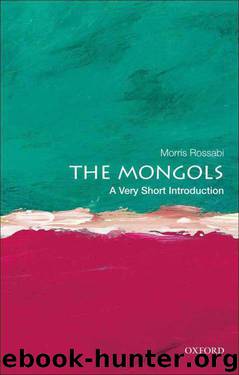The Mongols: A Very Short Introduction (Very Short Introductions) by Morris Rossabi

Author:Morris Rossabi [Rossabi, Morris]
Language: eng
Format: epub, mobi, azw3
Publisher: Oxford University Press
Published: 2012-04-05T16:00:00+00:00
Khubilai governs China
Once he became the uncontested Great Khan, Khubilai began to develop a hybrid administration, which would appeal to and incorporate both Chinese and Mongol elements. He was unwilling to turn over too much authority to his Chinese advisers nor was he eager to adopt the whole administrative apparatus from those of traditional Chinese dynasties. The most telling indication of his eagerness to modify the Chinese system was his refusal to reinstitute the civil service examinations. Restoring the exams would limit him to Confucian Chinese officials, and he could not afford to limit himself to a bureaucracy composed almost exclusively of the Mongols’ subjugated population.
He also deviated from traditional Chinese dynasties by dividing the population into three and, later, four groups. The Mongols occupied the most prominent positions, followed mostly by Muslims and other foreigners who would be recruited for important posts in government. The Chinese of the North and the Chinese of the South constituted the lowest-ranking groups and were excluded from some of the most important civil positions. High military positions were even more difficult for the Chinese to attain or to aspire to. Khubilai and other Mongols decidedly discriminated against Chinese of the official class.
Khubilai adopted these policies principally because the Chinese vastly outnumbered the Mongols in China. One source estimates that the Chinese in the North amounted to about ten million, and the Chinese in the South accounted for another sixty million while the Mongol population did not exceed one million. The Mongols needed to retain control of the leading positions in government and the military if they were to survive and avoid being engulfed by the Chinese.
Yet Khubilai wanted to establish an administrative structure that the Chinese would find familiar. Thus he restored the traditional body known as the Secretariat to take charge of civilian matters and established the Privy Council to supervise military matters. He also restored the six functional ministries that had implemented policy in China. These ministries oversaw the civilian officials, conducted censuses and collected taxes and tribute, managed court ceremonies and religions and dealt with foreign envoys, trained the military, enforced the laws and administered prisons, and maintained the infrastructure. Similarly, local administration resembled that of earlier Chinese dynasties, with China divided into provinces, circuits, and districts.
The principal difference between the Mongol and the Chinese dynasties was the greater emphasis on control. Fearing that officials, many of whom were Chinese, might be disloyal and corrupt, Khubilai delegated more power to a government body—known as the Censorate—than had any earlier Chinese dynasty. Censors, who could be crudely described as spies on the bureaucracy and the local elites, would periodically tour the country to ferret out financial abuses by the court, the military, or local government and would report directly to the Mongol emperor. However, the Mongols often allowed local Chinese elites considerable leeway to govern their regions as long as they paid taxes and performed the police, judicial, and military services required of them.
Download
The Mongols: A Very Short Introduction (Very Short Introductions) by Morris Rossabi.mobi
The Mongols: A Very Short Introduction (Very Short Introductions) by Morris Rossabi.azw3
This site does not store any files on its server. We only index and link to content provided by other sites. Please contact the content providers to delete copyright contents if any and email us, we'll remove relevant links or contents immediately.
The Art of Boudoir Photography: How to Create Stunning Photographs of Women by Christa Meola(18535)
Red Sparrow by Jason Matthews(5389)
Harry Potter 02 & The Chamber Of Secrets (Illustrated) by J.K. Rowling(3620)
In a Sunburned Country by Bill Bryson(3481)
Drawing Cutting Edge Anatomy by Christopher Hart(3450)
Figure Drawing for Artists by Steve Huston(3375)
Harry Potter and the Prisoner of Azkaban (Book 3) by J. K. Rowling(3304)
The Daily Stoic by Holiday Ryan & Hanselman Stephen(3228)
Japanese Design by Patricia J. Graham(3107)
The Roots of Romanticism (Second Edition) by Berlin Isaiah Hardy Henry Gray John(2877)
Make Comics Like the Pros by Greg Pak(2850)
Stacked Decks by The Rotenberg Collection(2808)
Draw-A-Saurus by James Silvani(2652)
Harry Potter and the Deathly Hallows (7) by J.K. Rowling(2638)
Tattoo Art by Doralba Picerno(2599)
On Photography by Susan Sontag(2574)
Churchill by Paul Johnson(2505)
The Daily Stoic by Ryan Holiday & Stephen Hanselman(2454)
Drawing and Painting Birds by Tim Wootton(2437)
